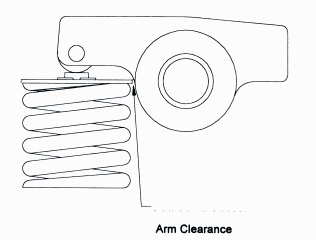How To Set Valve Spring Height
Valve Spring Pocket Clearance
Valve spring pocket clearance is the gap between the inside diameter of the valve jump pocket (or cup, if used) and the outside bore of the valve spring.
- Besides much clearance will upshot in the spring "dancing" around in the head, which "beats upwards" the spring mounting surface and the bound itself. If this is the case, a spring cup may be used. Boosted machining of the spring pocket may exist required to accept the spring cup.
- Not enough clearance will bind the spring in the pocket, overstressing the bottom coil by limiting its movement and not allowing the spring to "grow". This will cause the lesser coil to wear against the head and/or prematurely neglect. Machine the valve pocket using a Spring Seat Cutter if not enough clearance exists.

Valve Spring Servant Fit
The valve spring retainer should fit the valve spring existence used. A slightly snug fit is acceptable, notwithstanding a fit that is too tight can overstress the meridian curl, and crusade it to neglect. A fit that is likewise loose can lead to spring "dancing."
Valve Spring Installed Height
The installed height of the valve jump is the distance between the valve pocket (or cup, or shims) and the outer edge of the spring retainer (which is the summit of the valve spring) when the valve is closed. To check installed height, follow the following procedure:
- Install the valve in the guide.
- Install the servant and valve locks.
- Install all spring cups and/or valve spring shims (basically, everything except the valve jump).
- Hold the valve closed past pulling the retainer up tightly against the valve locks.
- Measure out the distance between the outside edge of the valve jump retainer and the spring seat. A snap gage or a peak micrometer should be used.
- Check the altitude against what is recommended on the camshaft specification bill of fare. An installed superlative of +/- 0.020" is acceptable.
- If the installed height is not within 0.020", either machining of the valve pocket, or removal/installation of valve bound shims is necessary.
- Repeat this procedure for the residual of the valves.

Valve Bound Retainer to Valve Seal Clearance
The distance between the innermost step on the valve jump retainer and the valve guide must exist 0.090" larger than the maximum valve lift of the camshaft. Mensurate the distance betwixt the top of the valve seal to the bottom of the valve leap servant. Afterwards adding 0.090" to your measurement, information technology should still exist larger than the maximum valve lift of the camshaft. If not, machining of the valve guide in necessary for adequate clearance.
Valve Bound Roll Clearance
Curl clearance is the distance betwixt the valve spring coils when the valve is it maximum elevator (fully open). A minimum of 0.060" must exist betwixt the coils at maximum elevator. Roll bind is when the valve leap is compressed fully-to the point that all of the coils are "stacked up" on tiptop of each other. For high RPM applications, .100" is recommended . Coil demark is a catastrophic condition that will result in valve railroad train failure. Disassemble each spring (if multiple springs are employed at each valve). Cheque all the springs (both inner, and outer springs) If at that place is non 0.060" - 0.100" minimum of clearance between the coils, the solutions are: the valve servant, the valve locks, the valve, or the jump must be changed; the spring pocket must be machined. Keep in listen that these modifications volition change the valve spring installed height

Valve Spring Retainer to Rocker Arm Clearance
When installing the rocker arms, check to meet that the inside of the rocker arms clear the spring retainers. Many rocker artillery have a "relief" to suit large valve spring retainers.
Valve Spring Run-In
Each set of Lunati valve springs are paw-selected to keep load variations below +/- 10% of the next. However, it is of import to "run in" your new valve springs at low RPM using the following procedure:
- Outset the engine and run the engine between 1500 and 2000 RPM until the engine reaches operating temperature.
- Shut off the engine and allow the springs to cool.
- After initial run-in, most springs will lose a slight amount of force per unit area. Re-bank check and shim up the valve springs if necessary. After the springs are "run in", spring pressure should remain constant until the indicate of replacement.
Source: https://www.lunatipower.com/valve-spring-tech

0 Response to "How To Set Valve Spring Height"
Post a Comment